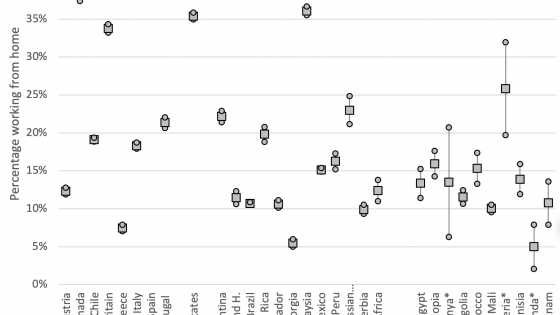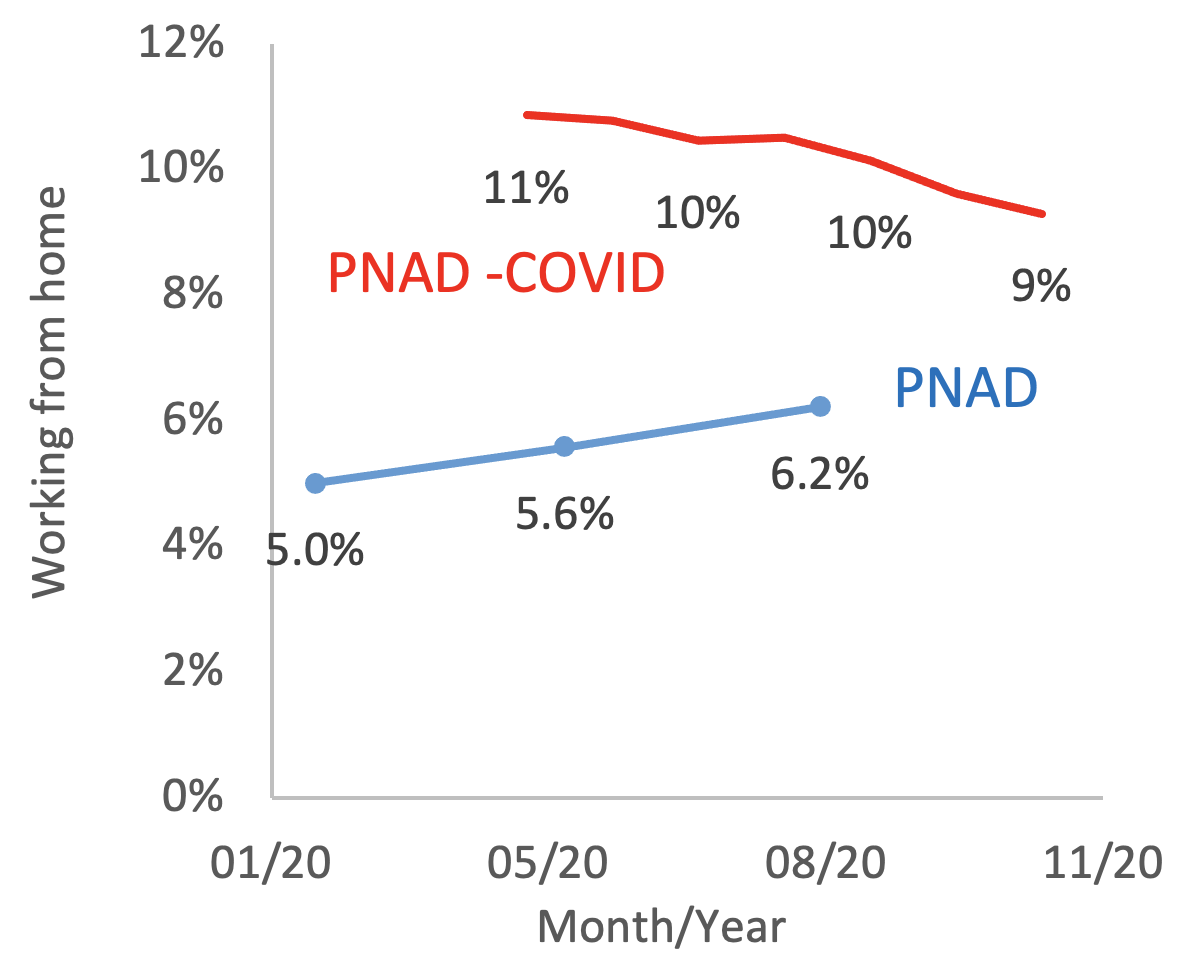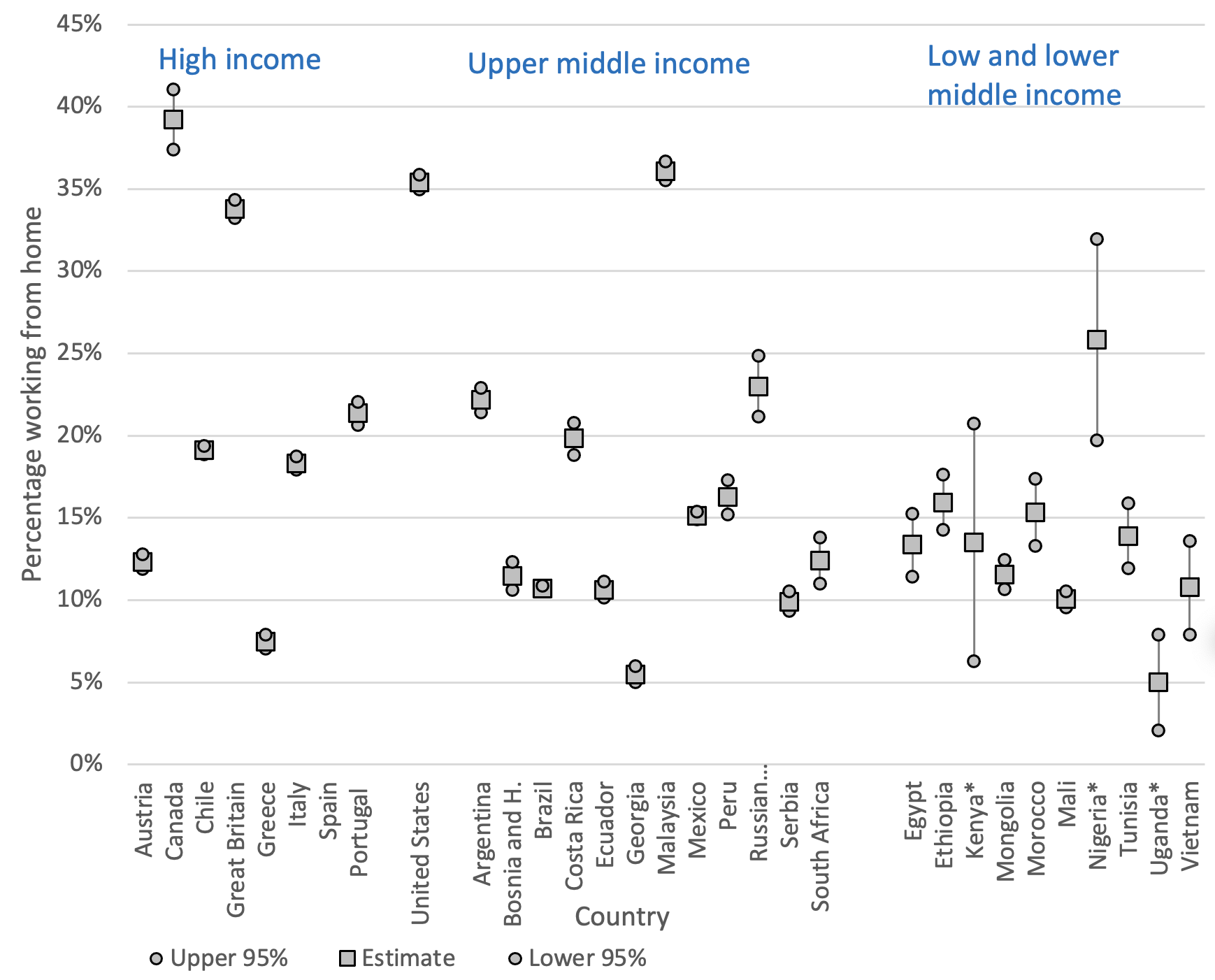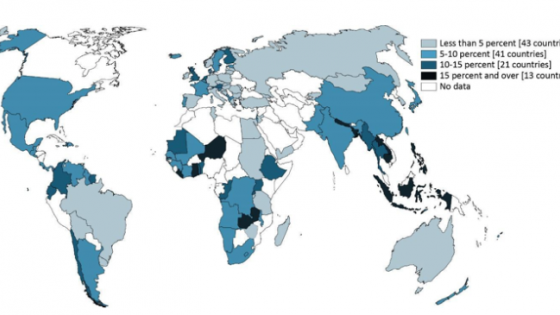At the onset of the COVID-19 crisis, scholars around the world estimated the potential of working from home given its efficacy as a measure that could mitigate the spread of the contagion while allowing productive activities to continue. One of the first studies was by Dingel and Neiman (2020), who used occupational descriptions from the Occupational Information Network (O*NET) to derive an estimate that 34% of American jobs could potentially be performed from home. Other scholars adapted their methodology to their particular country circumstance (e.g. Ramiro Albieu 2020 for Argentina and Boeri et al. 2020 for Europe).
Because the O*NET data are for the US, their application is limited to countries with a similar employment structure and working environment. As we were interested in estimating numbers for a world that includes labour markets from Uganda to the UK, we undertook a Delphi survey of labour market experts from across the world and then weighed these estimates by countries’ occupational shares (Berg et al. 2020, ILO 2020). We calculated that 18%, or approximately one in six workers at the global level, were potentially able to work from home. However, the variations by country income group were stark: our estimates for potential home-based work ranged from 27% of the workforce in high-income countries to 17% in middle-income countries and only 13% in low-income ones.
One year since the onset of the pandemic, we now have data from 33 household surveys covering 31 countries that can tell us how many workers were working from home during the second quarter of 2020. We therefore revisit our earlier estimates and derive a new estimate based on the existing survey data (see Soares et al. 2021 for more detail).
The challenge of measuring working from home during the pandemic: A closer look at labour force surveys
Knowing how many workers from across the world shifted to working from home during the pandemic has been difficult, as relatively few countries have household survey data that are both available for the pandemic period and include information on working from home. Moreover, the way the questions are posed differs, making the identification of homeworking difficult.
One crucial aspect is whether the question in the household survey asks from where you normally worked. This type of formulation may lead the respondent to think of a long period and not specifically of the COVID-19 pandemic. Therefore, it may not be sufficient to identify those working from home as a result of pandemic-related restrictions, as pandemic-induced work from home might be perceived as temporary and not typical over a longer period. Many surveys, of course, have always asked about place of work over a specific period such as the last four weeks.
In addition, with the advent of the COVID-19 pandemic and its ensuing lockdowns, a series of ad hoc questions were added to existing surveys and a number of ad hoc surveys were undertaken by different national statistical offices throughout the world. This created a new group of working from home questions that are highly varied.
The UK’s Opinions and Lifestyle Survey added COVID-related questions that distinguished between occasional and fulltime COVID-induced homework. Similarly, the Brazilian PNAD-Covid, which uses outgoing rotation groups from the regular PNADC and calls them by phone with a specific COVID-19 questionnaire, also includes a question designed with the pandemic in mind.
Because both the UK and Brazil have parallel surveys undertaken at the same time and with the same sampling scheme, we can compare how workers declare their place of work. In both countries, outgoing rotation groups are contacted for further questions, which means that they answered both the “usual” and “COVID-19” place-of-work questions, although in different surveys. Figures 1 and 2 show the results.
Figure 1 Great Britain (LFS vs OLS)
Figure 2 Brazil (PNAD-C vs PNAD-Covid)
Sources: UK LFS, Brazil PNAD COVID and Brazil PNADC microdata. UK OLS data from ONS.
In the UK, the Opinions and Lifestyle Survey (OLS) average for the work at home question was 33.8% of those employed but the Labour Force Survey figure was 7.8% – about a quarter of the OLS number. For Brazil the differences are less dramatic but still very significant at 5.6% and 11%. In other words, the wording of the place-of-work question is crucial.
In addition, the surveys show opposing trends. Even as the COVID-specific questions show a decrease in home-based work, the “usual place of work” questions show an increase. The obvious interpretation is that growing numbers of workers, after many months at home, begin to think of this work arrangement as the ‘new normal’ and not anomalous.
Other countries took a different approach, such as the question added to the American CPS: “At any time in the LAST 4 WEEKS, did you telework or work at home for pay BECAUSE OF THE CORONAVIRUS PANDEMIC?” This is a difficult question to work with because it creates both upward and downward biases. On the one hand, those who have always worked from home may answer no due to the “because of the coronavirus pandemic” qualifier. On the other hand, those who worked from home only occasionally would answer yes, whereas a person under the same working arrangement would answer no to a question requiring that home be the main place of work. For this reason, we treat the US as a special case in the calculations.
As our focus is on how many people were effectively working from home during the second quarter of 2020, we choose formulations of the place of work question that are consistent with the question we are trying to answer, namely questions that define specific reference periods for working from home and eschew questions about “usual” or “normal” place of work. Luckily, almost all of the 33 surveys we base our estimates upon define specific reference periods.
Estimating working from home using existing household surveys
The countries for which we have surveys represent 43% of employment in high-income countries, 19% in upper-middle-income ones and only 14% of lower-middle-income and low-income ones.1 We therefore stratify countries by income level to derive a worldwide estimate. Nevertheless, there are two important limitations.
The first and most obvious is the limited number of countries used to extrapolate a figure for the entire world. In particular, although some high-population countries such as the US, the Russian Federation and Brazil are in the figures, China, India and Indonesia are not. The second limitation concerns the sample size of some of the surveys, particularly the ad hoc COVID surveys. The sampling errors are much larger for lower-middle-income and low-income countries; while this does not have an impact on the estimate, it does affect the confidence intervals (see Figure 3).
Figure 3 Confidence intervals (95%) for home-based work, by country (survey)
Source: Household, labour force and ad hoc COVID-19 surveys.
Note: 95% confidence intervals are calculated using the normality assumption. Since variances are estimated and not known, a t-distribution would be more appropriate. For large samples, the difference is small.
Calculating the number of individuals working from home during the COVID-19 pandemic
As predicted in the estimates of homeworking potential, the higher the income of the country, the higher the percentage of workers carrying out their work from home. For the US, the figure was 35.4%, and for other high-income countries it was 25.4%. For upper-middle-income countries, the figure was 17.1% and for the lower-middle and low-income country group, it was 13.6%. Using these strata, the global number of workers working from home was estimated at 558 million, which corresponds to 17.4% of global employment (see Table 1).
This number is quite close to our estimates published in May 2020 based on the expert forecasts and adjusted for the occupational distribution of employment (Berg et al. 2020, ILO 2020). The results, which appear in the last column of the table, are surprisingly close: 17.4% for the estimate based on household data versus 18% for the expert assessments.
Table 1 Estimates for the proportions of workers working from home during Q2 2020
Note: *Excluding US.
Source: Household, labour force and ad hoc COVID-19 surveys.
References
Albrieu, . (2020), “Evaluando las oportunidades y los límites del teletrabajo en Argentina en tiempos del COVID-19”, CIPPEC.
Berg, J, F Bonnet and S Soares (2020) “Working from Home: Estimating the Worldwide Potential”, VoxEU.org, 11 May.
Boeri, T, A Caiumi and M Paccagnella (2020), “Mitigating the work-safety trade-off”, Covid Economics 2, 8 April.
Dingel, J and B Neiman (2020), “How Many Jobs Can be Done at Home?”, NBER Working Paper 26948 (see also the Vox column here)
ILO (2020) “Working from Home: Estimating the worldwide potential,” ILO policy brief.
Soares, S, F Bonnet and J Berg (2021) “From potential to practice: Preliminary findings on the numbers of workers working from home during the COVID-19 pandemic,” ILO policy brief.
Endnotes
[1] The countries are: Argentina, Austria, Bosnia and Herzegovina, Brazil, Canada, Chile, Costa Rica, Ecuador, Egypt, Ethiopia, Georgia, Great Britain, Greece, Italy, Kenya, Malaysia, Mali, Mexico, Mongolia, Morocco, Nigeria, Peru, Portugal, Russian Federation, Serbia, South Africa, Spain, Tunisia, Uganda, United States, Vietnam. The authors thank Vladimir Gimpleson for help on localising data on the Russian Federation.









